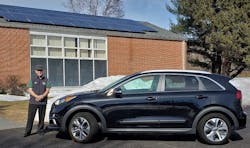After teaching hybrids for ten years at ACDC (my third automotive business), I bought a new 2011 Chevy Volt to add to our existing fleet of the best-selling hybrids from Honda, Toyota and Ford. This was an exciting time as this had a plug to charge the high voltage battery and it was no longer nickel metal hydride (NiMH). ACDC now had more to learn and pass onto the industry, so we got to work!
On a good day, the Volt has a range of about 37 miles on battery power only (it has a back-up gas engine). If I drive back roads at 35 mph maybe I can squeeze out 45 miles. During the winter in central Massachusetts, the range is less than 20 miles on electric power only.
A couple years later ACDC bought a used 2011 Leaf to advance our knowledge. The range on the Leaf was 85 miles in the summer, but only 50 miles in the winter.
ACDC leased a Chevy Bolt EV in 2017 and this EV had a range of 230 miles in the summer, but again the winters took it down to 160 miles.
What did they all have in common? The cabin heat was created by the high voltage pack heating antifreeze for the heater core. How old school.
Once the lease was up in 2020, ACDC was in the market to buy an EV for training and longer distance driving in cold weather. The answer to that was a 2019 Kia Niro EV. It had two components that we lacked at our school: a DC faster charger known as CCS (Combined Charging System) and a heat pump.
Heating Coolant or Using a Heat Pump
Once affordable modern electric cars were offered worldwide in 2010, the heating of the cabin became a customer concern in cold weather. To provide cabin heat, a small container of coolant was heated using the high voltage (HV) battery for power, and that hot coolant was pushed into the heater core with a 12-volt motorized pump. The 2011 Nissan Leaf used a German made coolant HV heater, but it decreased the driving range. That old-fashioned technology (still in use) lasted only two model years before Nissan, in model year (M/Y) 2013, came out with a heat pump. That reduced the load on the battery from approximately 6 kW to 2 kW, for the same amount of heat. This allowed the EV to go farther on a charge while keeping the occupants comfortable. To stay warm is a human desire, but in the beginning many early EV adopters used the heated seats and heated steering wheel, while wearing a jacket, hat and gloves, to stay warm with the heat off. That was not the solution most drivers would put up with.
How does a heat pump work? In simple terms, the condenser and evaporator change places by adding another expansion valve before the condenser. Then more tubing was added to bypass each expansion valve and the computer, depending on a request for heat or A/C, used one expansion valve or the other. In this way the heat is then produced in the cabin as you try to cool the air outside the vehicle. Heat pumps have been used in buildings since the 1940s, but the concept goes back to the mid-1850s.
When Nissan installed their version of a heat pump it was not used on the base model, the Leaf “S”, for the first six months of production, but by mid-year, all Leafs were using heat pumps. In M/Y 2015 the new Kia Soul EV added a “tweak” to its heat pump to make it more efficient. Toyota (Denso) then improved it again in the M/Y 2017 Prius Prime that allowed the heat pump to work at lower ambient temperatures. The Kia Niro EV, in M/Y 2019, added two more valves that kept the technology advancing to use less battery energy to warm the cabin and finally in 2021 the Tesla Model Y came out with the “Octovalve,” Tesla’s first heat pump.
If you have been keeping track, since 2013, every two years the heat pump has been redesigned and with that has come improvements. Why all these changes? Consumers wanted more range in cold weather.
We will examine the ACDC generic heat pump (see illustration above) we use in our classroom to help repair technicians understand the concept. The system has what looks like two evaporators. The traditional one is (11) and the second one is used for heating the cabin (2). The condenser (5) has two jobs as we will explain. The compressor (1) is a typical high voltage scroll type and uses an accumulator (9). The accumulator prevents any liquid from entering the compressor. Two 12-volt solenoid three-way valves (3 and 6) are fitted before each expansion valve (4 and 10) with a bypass line to direct the refrigerant either to the expansion valve or around it.
The “three-way valves,” as they are referred to by the OEMs, have only two directions. The switching of the valves will allow the refrigerant to keep going straight through the same pipe, or be redirected to another pipe. It has only two choices and only one expansion valve is open at any one time. There are also sub-systems that are needed to support a heat pump in damp and very cold weather, or a sub-system to make it perform better. Expect more improvements in the future, and if the past can predict the future, it will be in 2023.
Chiller
If there was ever a poor choice of words, calling something that gets hot a “chiller” would be it (8). It cools the power electronics (PE) (7) but its purpose in the HVAC system is to warm the refrigerant on its way back to the compressor. That makes it easier for the HV compressor to do its job. Less effort equals less energy from the HV battery and more range. A lot more range? No, but every little bit helps. The PE coolant had not been used on the Nissan Leaf before, so now we are recycling energy (a Kia idea) we otherwise would lose as waste heat. Clever, those engineers. Reduce, Reuse and Recycle can be applied to transportation these days. Using wasted energy is smart. Wasting energy is not.
Condenser Icing
When the heat pump is on and the outside climate is wet and above freezing (33F to 45F or 1C to 7C), the outside of the condenser (5) may freeze as the air moving through the condenser lowers the air pressure and the temperature drops. If the condenser has iced up, the heat pump system stops working. What do we do? The HVAC computer will turn the A/C back on as this will now melt the ice when the condenser gets hot. Air flaps in the evaporator will move the “cold air” from the A/C outside as the HV air grid heater (12) is turned on to heat the cabin. At this point the main battery pack (13) will be asked to provide more energy than when the heat pump was the sole provider of cabin heat. As the outside (ambient) temperature drops below freezing and/or the air dries out, the front condenser will stop icing up. This is all done without the driver knowing what is going on.
My company’s job is to provide training and tech support to the world’s independent EV technicians that will be asked to fix and maintain the systems as they age. This makes for an interesting job.
About the Author

Craig Van Batenburg
Craig Van Batenburg is the CEO of ACDC, a hybrid and plug-in training company based in Worcester, Mass. ACDC has been offering high voltage classes since 2000, when the Honda Insight came to the USA. When EVs were introduced in 2011, ACDC added them to their classes. Reach Craig via email at [email protected] or call him at (508) 826-4546. Find ACDC at www.FIXHYBRID.com.
